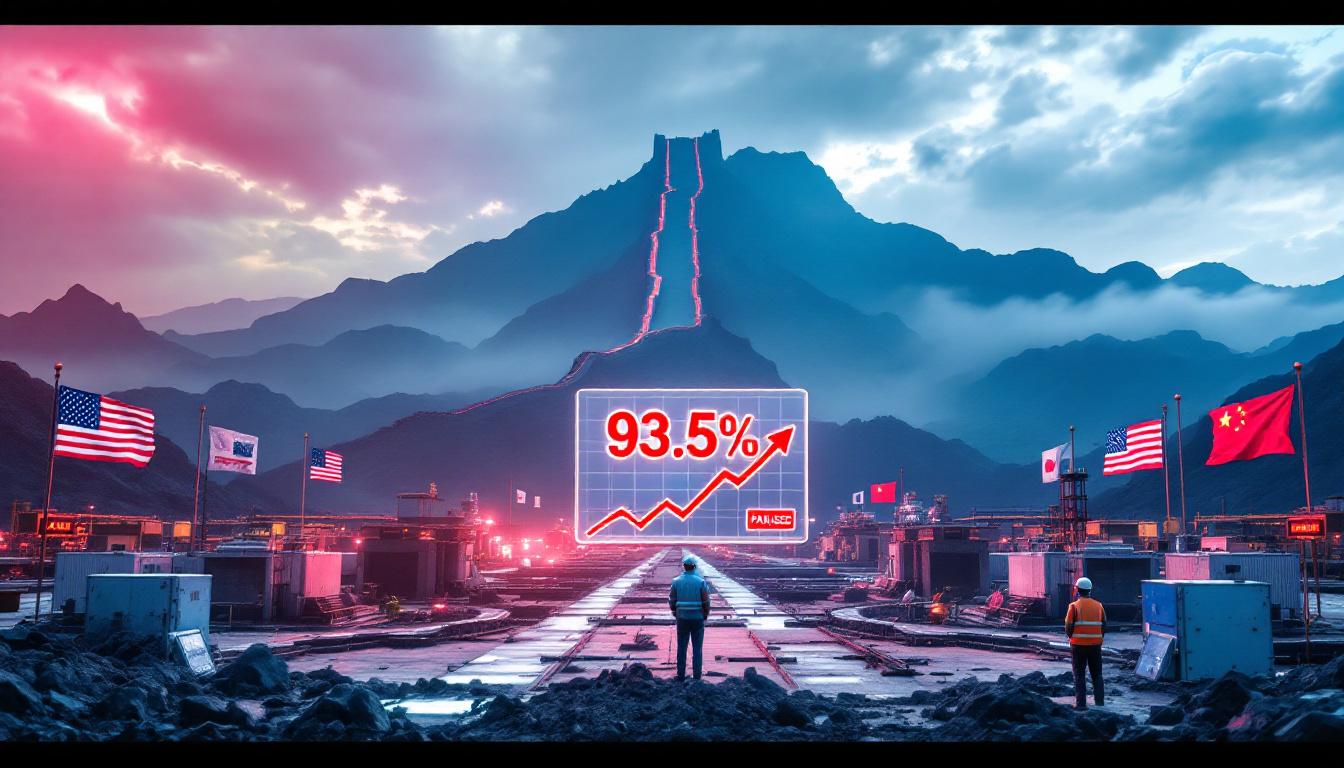India's Strategic Pivot: Expanding Rare Earth Partnerships with Africa
In a significant geopolitical development, India is actively pursuing partnerships with African nations to secure access to rare earth minerals, critical for advanced technologies and defense systems. This strategic pivot comes as global powers increasingly recognize the strategic importance of these resources in an era of technological competition and supply chain vulnerabilities.
Why is India Pursuing Rare Earth Partnerships in Africa?
Africa's vast mineral wealth presents a strategic opportunity for India to reduce its dependence on Chinese rare earth supplies. With China controlling approximately 90% of global rare earth production, India's recent diplomatic initiatives aim to diversify supply chains and strengthen its strategic autonomy in critical mineral access.
India's Minister of State for Atomic Energy, Jitendra Singh, confirmed in July 2025 that "New Delhi has active cooperation agreements with several mineral-rich countries, including key African suppliers of rare earth elements and other critical minerals," highlighting the urgency and importance of these partnerships.
The Geopolitical Context Behind India's African Strategy
China rare earth disruption became particularly concerning when it restricted exports of rare-earth magnets earlier in 2025, creating global supply disruptions. This move underscored the vulnerability of nations dependent on single-source supply chains for critical materials.
For India, Africa represents not just an alternative source of supply but a strategic partner in building resilience against market manipulation. The continent's abundant reserves of neodymium, dysprosium, cobalt, and lithium align perfectly with India's technological and industrial ambitions.
- China's tightening grip on rare earth exports through export quotas and licensing requirements
- Growing recognition of rare earths as strategic resources rather than mere commodities
- India's push for greater self-reliance in critical technologies as part of its broader Atmanirbhar Bharat initiative
- Shifting global alliances in mineral resource access as countries reassess supply chain vulnerabilities
How Does China Dominate the Global Rare Earth Market?
China has established unprecedented control over the rare earth supply chain through decades of strategic investment and policy decisions. This dominance has created vulnerabilities for countries dependent on these materials for advanced manufacturing and defense technologies.
China's strategy wasn't accidental—it represents a long-term vision that began in the 1980s when Deng Xiaoping famously remarked that "rare earths are to China what oil is to the Middle East." Through systematic development of mining operations, processing facilities, and downstream manufacturing, China transformed this vision into reality.
China's Rare Earth Dominance by the Numbers
| Aspect of Dominance | China's Position | Global Impact |
|---|---|---|
| Global production share | >90% | Creates single-source dependency |
| Processing capacity | Dominates separation and refining | Bottleneck for alternative suppliers |
| Export restrictions | Implemented in early 2025 | Disrupted global supply chains |
| Rare earth magnets | Controls majority of production | Critical for green tech and defense |
This market concentration gives China significant leverage in trade negotiations and geopolitical disputes. When China restricted rare earth magnet exports in early 2025, it sent shockwaves through global supply chains, particularly affecting high-tech manufacturing and defense industries.
"These materials are no longer viewed as mere commodities but as instruments of strategic leverage in an increasingly competitive global landscape," noted industry analysts at FurtherAfrica in their July 2025 report on India's rare earth initiatives.
What Are India's Strategic Objectives in African Mineral Partnerships?
India's outreach to mineral-rich African nations represents a comprehensive approach to securing access to critical materials while offering mutually beneficial development opportunities.
At the core of India's strategy is a multifaceted partnership model that goes beyond simple resource extraction. As confirmed by Minister Jitendra Singh, these partnerships encompass "exploration collaboration, technology transfer, joint ventures, and long-term offtake agreements"—creating a framework for sustainable cooperation.
Key Elements of India's African Mineral Strategy
- Securing Supply Resilience: Establishing bilateral cooperation agreements with resource-rich nations to ensure consistent access to critical minerals reserve
- Knowledge Development: Creating joint exploration initiatives that benefit from both Indian technical expertise and African geological knowledge
- Technological Advancement: Developing technology transfer frameworks that enhance local processing capabilities
- Value Addition: Forming strategic partnerships for processing facilities to create opportunities for industrialization in Africa
- Long-term Planning: Securing extended supply arrangements that provide predictability for both Indian industries and African producers
Unlike traditional extractive relationships, India's approach emphasizes creating opportunities for "industrialization and value addition on the continent," positioning these partnerships as vehicles for mutual development rather than one-sided resource extraction.
Which African Nations Are Critical to India's Rare Earth Strategy?
Several African countries possess significant deposits of rare earth elements and other critical minerals that align with India's strategic needs. These nations offer alternatives to China-dominated supply chains.
While specific country partnerships remain confidential, geological surveys have identified substantial rare earth potential across the continent, with particularly promising deposits in eastern and southern African nations.
Africa's Strategic Mineral Landscape
Africa's geological diversity offers access to a wide range of critical minerals beyond just rare earths. The continent hosts abundant reserves of neodymium and dysprosium—essential components for permanent magnets used in electric vehicles and wind turbines—along with cobalt and lithium required for battery technologies.
- East African Rift System: Rich in heavy rare earth elements due to alkaline volcanic activity
- Southern African Carbonatite Complexes: Significant light rare earth element concentrations
- West African Pegmatite Belts: Host to lithium, tantalum, and cesium deposits complementary to rare earth supply chains
- Central African Copper Belt: Critical for Congo lithium investments and other battery materials that complement rare earth applications
The development of these resources requires careful consideration of local mining regulations, infrastructure limitations, and political stability factors—all of which influence India's partnership selection process.
How Do Rare Earths Factor into Modern Technology and Defense Systems?
Understanding the technological applications of rare earth elements helps contextualize their strategic importance in global power dynamics and India's motivation for securing diverse supply sources.
Rare earth elements are fundamental to technologies "at the heart of" renewable energy systems, advanced electronics, and defense applications. Despite their name, most rare earths are relatively abundant in the Earth's crust, but economic concentrations are scarce and processing is complex.
Critical Applications of Rare Earth Elements
| Element | Key Applications | Strategic Significance |
|---|---|---|
| Neodymium | Permanent magnets, wind turbines, EV motors | Essential for energy transition security |
| Dysprosium | High-temperature magnets, nuclear reactors | Critical for defense applications |
| Lanthanum | Catalytic converters, battery electrodes | Automotive and energy storage |
| Cerium | Polishing powders, catalysts | Semiconductor manufacturing |
| Yttrium | Laser technologies, phosphors | Advanced electronics |
The unique electronic, magnetic, and luminescent properties of these elements make them irreplaceable in many advanced applications. A single F-35 fighter jet, for example, contains approximately 417 kg of rare earth materials—highlighting their importance in defense systems.
"The nation that controls these materials controls the future of technology," notes a prominent analysis of critical mineral supply chains, underscoring why countries like India view rare earth access as a matter of national security.
What Benefits Can African Nations Gain from Indian Partnerships?
For African countries, partnerships with India offer alternatives to traditional resource extraction models that have historically provided limited local economic benefits.
India's approach emphasizes mutual development rather than simple extraction, creating opportunities for African nations to capture more value from their mineral resources. This represents a significant departure from historical patterns of resource exploitation on the continent.
Potential Advantages for African Partners
- Knowledge Transfer: Technology sharing for exploration, mining, and initial processing
- Value Chain Integration: Development of processing facilities that create higher-value products within Africa
- Skill Development: Training programs and workforce development in technical areas
- Infrastructure Enhancement: Investment in transportation, energy, and water systems that benefit broader economic activities
- Market Diversification: Reduced dependence on single buyers for mineral exports
- Research Collaboration: Joint research initiatives on more efficient extraction and processing methods
By fostering industrialization and value addition on the continent, these partnerships align with the African Union's Agenda 2063, which emphasizes resource-led development and economic transformation. The focus on "joint ventures" rather than simple purchase agreements creates pathways for shared prosperity through South Africa beneficiation and similar initiatives across the continent.
How Does India's Approach Differ from China's Engagement in Africa?
India's strategy for mineral partnerships in Africa presents distinct differences from China's established approach, potentially offering African nations alternative development pathways.
While both Asian powers seek resource security, their engagement models reflect different priorities and values. India's emphasis on mutual development contrasts with China's infrastructure-focused approach, creating competitive dynamics that may benefit African nations through improved partnership terms.
Comparative Approaches to African Partnerships
| Aspect | India's Approach | China's Approach |
|---|---|---|
| Partnership model | Emphasis on mutual development and joint ventures | Resource-for-infrastructure exchanges and concessional loans |
| Technology transfer | Focus on skills development and local capacity | Limited knowledge sharing with emphasis on turnkey solutions |
| Environmental standards | Alignment with international norms and sustainable practices | Variable implementation with focus on rapid development |
| Governance implications | Supports institutional capacity and transparent agreements | Project-focused engagement with bilateral negotiation |
India's partnership approach emphasizes technology transfer and joint ventures, creating opportunities for African partners to develop indigenous capabilities rather than remaining dependent on foreign expertise. This contrasts with China's model, which has historically focused on infrastructure development in exchange for resource access.
What Challenges Must India Overcome in Developing African Rare Earth Partnerships?
Despite strategic alignment, significant obstacles remain in establishing effective India-Africa rare earth cooperation. Addressing these challenges will be crucial for successful implementation.
The path from strategic vision to operational reality involves navigating complex technical, financial, and political landscapes. India faces competition not only from China but also from Western nations and consortiums seeking to secure their own critical mineral supplies.
Key Implementation Challenges
- Infrastructure Gaps: Many promising mineral deposits in Africa lack the transportation, energy, and water infrastructure necessary for commercial development
- Technical Complexity: Rare earth processing requires sophisticated technology and expertise not yet widely available in either India or most African nations
- Investment Requirements: Developing rare earth supply chains demands substantial capital investment with extended payback periods
- Regulatory Harmonization: Differing mining codes, environmental standards, and investment frameworks across African nations complicate unified approaches
- Geopolitical Competition: Established players may employ various strategies to maintain market dominance and discourage new entrants
- Political Risk Management: Ensuring continuity of agreements across political transitions in partner countries
Overcoming these challenges requires patient capital, technical innovation, and diplomatic skill. India will need to leverage its strengths in information technology, pharmaceutical manufacturing, and space technology to offer compelling partnership benefits beyond simple resource purchases.
How Might India-Africa Rare Earth Cooperation Reshape Global Supply Chains?
The development of alternative rare earth supply chains could have far-reaching implications for global markets and geopolitical relationships beyond the immediate bilateral partnerships.
As India strengthens rare earth ties with Africa and new supply pathways emerge, the resulting market diversification could reduce price volatility and enhance global access to these critical materials. This evolution may trigger broader realignments in technology supply chains and manufacturing networks.
Potential Global Impact of New Supply Chains
- Market Stabilization: Reduced concentration of supply leading to more predictable pricing and availability
- Technology Access: Wider availability of rare earth materials enabling broader adoption of advanced technologies
- Strategic Realignment: New partnerships influencing broader diplomatic and security relationships
- Processing Innovation: Competitive pressure driving improvements in extraction efficiency and environmental performance
- Sustainability Standards: Development of more responsible mining practices through diversified approaches
In the longer term, successful India-Africa partnerships could contribute to a more balanced global rare earth ecosystem, reducing the ability of any single nation to weaponize these critical resources for geopolitical advantage.
What Does the Future Hold for India-Africa Mineral Partnerships?
Looking ahead, several factors will shape the evolution and effectiveness of India's rare earth strategy in Africa, with implications for both regional development and global resource politics.
The coming decade will likely see experimental partnerships evolve into more structured, institutionalized relationships. Success will depend on India's ability to deliver on promises of technology transfer and value addition while navigating changing technological landscapes.
Future Development Pathways
- Expanded Material Focus: Moving beyond rare earths to create comprehensive critical mineral partnerships
- Renewable Integration: Linking mineral development with renewable energy expansion in both regions
- Regional Processing Hubs: Establishing specialized processing centers serving multiple African producers
- Research Ecosystems: Creating joint innovation networks to address extraction and processing challenges
- Multilateral Frameworks: Potentially incorporating like-minded partners such as Japan, Australia, or European nations
According to recent analysis by African Leadership Magazine, the most successful partnerships will likely evolve beyond simple buyer-seller relationships into integrated industrial ecosystems that capture more value within both African and Indian economies.
FAQ: India-Africa Rare Earth Partnerships
What specific rare earth elements are most abundant in Africa?
Africa hosts significant deposits of various rare earth elements, with particularly notable concentrations of neodymium, praseodymium, and dysprosium in several countries. These elements are especially valuable for permanent magnets used in electric vehicles and wind turbines.
How quickly could new India-Africa partnerships affect global rare earth markets?
Developing new rare earth supply chains typically requires 5-7 years from exploration to production. While some existing operations could be expanded more quickly, meaningful market impact would likely emerge gradually over the next decade.
Will India develop processing capabilities or remain dependent on external refiners?
India's strategy appears to include development of domestic processing capabilities, potentially in partnership with African nations. This vertical integration approach aims to address the critical middle stages of the rare earth value chain.
How might Western nations respond to India's rare earth initiatives in Africa?
Western countries pursuing their own critical mineral security strategies may view India's efforts as complementary to broader efforts to diversify global supply chains, potentially leading to multilateral cooperation frameworks.
Further Reading
For deeper insight into Africa's mineral potential and emerging partnerships, readers can explore regional perspectives from specialized sources like FurtherAfrica, which offers analytical coverage of the continent's resource development landscape.
Disclaimer: This article contains forward-looking statements regarding geopolitical developments and strategic partnerships. Future outcomes may vary based on technological developments, policy changes, and evolving international relationships. Readers should consider multiple information sources when evaluating strategic mineral investments or policy positions.
Ready to Discover the Next Major ASX Mineral Discovery?
Don't miss out on significant investment opportunities in the mining sector – Discovery Alert's proprietary Discovery IQ model delivers real-time notifications of major mineral discoveries on the ASX, giving you a crucial market advantage. Explore why historic discoveries generate substantial returns by visiting the Discovery Alert discoveries page and position yourself ahead of the market.




